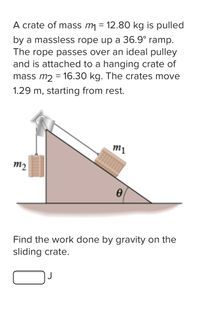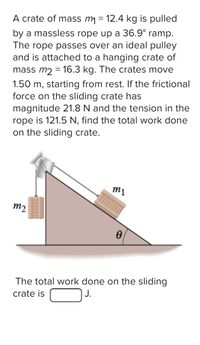
College Physics
11th Edition
ISBN: 9781305952300
Author: Raymond A. Serway, Chris Vuille
Publisher: Cengage Learning
expand_more
expand_more
format_list_bulleted
Concept explainers
Topic Video
Question
thumb_up100%

Transcribed Image Text:A crate of mass m = 12.80 kg is pulled
by a massless rope up a 36.9° ramp.
The rope passes over an ideal pulley
and is attached to a hanging crate of
mass m2 = 16.30 kg. The crates move
1.29 m, starting from rest.
m1
m2
Find the work done by gravity on the
sliding crate.

Transcribed Image Text:A crate of mass m = 12.4 kg is pulled
by a massless rope up a 36.9° ramp.
The rope passes over an ideal pulley
and is attached to a hanging crate of
mass m2 = 16.3 kg. The crates move
%3D
1.50 m, starting from rest. If the frictional
force on the sliding crate has
magnitude 21.8 N and the tension in the
rope is 121.5 N, find the total work done
on the sliding crate.
m1
m2
The total work done on the sliding
J.
crate is
Expert Solution
This question has been solved!
Explore an expertly crafted, step-by-step solution for a thorough understanding of key concepts.
This is a popular solution
Trending nowThis is a popular solution!
Step by stepSolved in 4 steps with 2 images

Knowledge Booster
Learn more about
Need a deep-dive on the concept behind this application? Look no further. Learn more about this topic, physics and related others by exploring similar questions and additional content below.Similar questions
- Four students are playing tug-of-war. The two students on the right pull with forces of magnitude 55N and 65N, and weight 60kg and 62kg. The two students on the left pull with forces of magnitude 58N and 70N, and weight 59kg and 64kg. What are the e magnitude and direction of the acceleration of the students?arrow_forwardA particle of mass 5.30 kg is acted on by a single force of 32.2 N. If the particle starts at rest, how far does it travel in the first 15.0 s?arrow_forwardThe crate A weighs 780 lb. Between all contacting surfaces, μs = 0.34 and μk = 0.29. Neglect the weights of the wedges. What force F is required to move A to the right at a constant rate? Wedge angle is 6 degrees.arrow_forward
- The figure shows two blocks connected by a cord (of negligible mass) that passes over a frictionless pulley (also of negligible mass). The arrangement is known as Atwood's machine. Block 1 has mass m1 = 1.4 kg; block 2 has mass m2 = 3.7 kg. What are (a) the magnitude of the blocks' acceleration and (b) the tension in the cord? (a) Number i Units (b) Number Units >arrow_forwardTwo teams of nine members each engage in a tug of war. Each of the first team's members has an average mass of 72 kg and exerts an average force of 1350 N horizontally. Each of the second team's members has an average mass of 77 kg and exerts an average force of 1373 N horizontally. (a) What is the acceleration (in m/s2 in the direction the heavy team is pulling) of the two teams?arrow_forwardThe figure shows two blocks connected by a cord (of negligible mass) that passes over a frictionless pulley (also of negligible mass). The arrangement is known as Atwood's machine. Block 1 has mass m1 = 1.1 kg; block 2 has mass m2 = 2.1 kg. What are (a) the magnitude of the blocks' acceleration and (b) the tension in the cord? (a) Number i Units (b) Number i Units >arrow_forward
- as a fish jump vertically out of the water, assume that only two significant forces act on it: an upward force F exerted by the tail fin and the downward force due to gravity. a force chinook salmon has a length of 1.50 m and a mass of 48.5 kg. if the fish is moving upward at 3.00 m/s as its head first breaks the surface and has an upward speed of 5.80 m/s after two-thirds of its length has left the surface, assume constant acceleration and determine the following. a. the salmon's acceleration b. the magnitude of the force F during this intervalarrow_forwardIn (Figure 1), F={300i-100j+550k}NF= (300i-100j+550k)N. Determine the magnitude of the projection of the force FF acting along the cable BA◆◆. Express your answer to three significant figures and include the appropriate units. Figure 2m 6m 1 of 1 3marrow_forwardTwo blocks of mass m1 = 0.6 kg and m2 = 2.4 kg are connected by a massless string, as shown in the Figure. They are released from rest. The coefficent of kinetic friction between the upper block and the surface is 0.27. Calculate the speed of the blocks after they have moved a distance 53 cm. Assume that the pulley is massless and frictionless.arrow_forward
- An antelope is being pulled by two forces whose vector-component expressions are: F1 = 3.6Ni + -8.9Nj + -3.7Nk F2 = 8.2Ni + -1.7Nj + 2.4Nk What is the angle (in degrees) between these two vectors?arrow_forwardThe figure shows two blocks connected by a cord (of negligible mass) that passes over a frictionless pulley (also of negligible mass). The arrangement is known as Atwood's machine. Block 1 has mass m1 = 1.2 kg; block 2 has mass m2 = 1.7 kg. What are (a) the magnitude of the blocks’ acceleration and (b) the tension in the cord?arrow_forwardThe steel I-beam in the drawing has a weight of 1.51 × 103 N and is being lifted at a constant velocity. What is the tension in each cable attached to its ends?arrow_forward
arrow_back_ios
arrow_forward_ios
Recommended textbooks for you
 College PhysicsPhysicsISBN:9781305952300Author:Raymond A. Serway, Chris VuillePublisher:Cengage Learning
College PhysicsPhysicsISBN:9781305952300Author:Raymond A. Serway, Chris VuillePublisher:Cengage Learning University Physics (14th Edition)PhysicsISBN:9780133969290Author:Hugh D. Young, Roger A. FreedmanPublisher:PEARSON
University Physics (14th Edition)PhysicsISBN:9780133969290Author:Hugh D. Young, Roger A. FreedmanPublisher:PEARSON Introduction To Quantum MechanicsPhysicsISBN:9781107189638Author:Griffiths, David J., Schroeter, Darrell F.Publisher:Cambridge University Press
Introduction To Quantum MechanicsPhysicsISBN:9781107189638Author:Griffiths, David J., Schroeter, Darrell F.Publisher:Cambridge University Press Physics for Scientists and EngineersPhysicsISBN:9781337553278Author:Raymond A. Serway, John W. JewettPublisher:Cengage Learning
Physics for Scientists and EngineersPhysicsISBN:9781337553278Author:Raymond A. Serway, John W. JewettPublisher:Cengage Learning Lecture- Tutorials for Introductory AstronomyPhysicsISBN:9780321820464Author:Edward E. Prather, Tim P. Slater, Jeff P. Adams, Gina BrissendenPublisher:Addison-Wesley
Lecture- Tutorials for Introductory AstronomyPhysicsISBN:9780321820464Author:Edward E. Prather, Tim P. Slater, Jeff P. Adams, Gina BrissendenPublisher:Addison-Wesley College Physics: A Strategic Approach (4th Editio...PhysicsISBN:9780134609034Author:Randall D. Knight (Professor Emeritus), Brian Jones, Stuart FieldPublisher:PEARSON
College Physics: A Strategic Approach (4th Editio...PhysicsISBN:9780134609034Author:Randall D. Knight (Professor Emeritus), Brian Jones, Stuart FieldPublisher:PEARSON

College Physics
Physics
ISBN:9781305952300
Author:Raymond A. Serway, Chris Vuille
Publisher:Cengage Learning

University Physics (14th Edition)
Physics
ISBN:9780133969290
Author:Hugh D. Young, Roger A. Freedman
Publisher:PEARSON

Introduction To Quantum Mechanics
Physics
ISBN:9781107189638
Author:Griffiths, David J., Schroeter, Darrell F.
Publisher:Cambridge University Press

Physics for Scientists and Engineers
Physics
ISBN:9781337553278
Author:Raymond A. Serway, John W. Jewett
Publisher:Cengage Learning

Lecture- Tutorials for Introductory Astronomy
Physics
ISBN:9780321820464
Author:Edward E. Prather, Tim P. Slater, Jeff P. Adams, Gina Brissenden
Publisher:Addison-Wesley

College Physics: A Strategic Approach (4th Editio...
Physics
ISBN:9780134609034
Author:Randall D. Knight (Professor Emeritus), Brian Jones, Stuart Field
Publisher:PEARSON